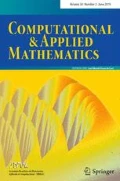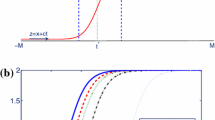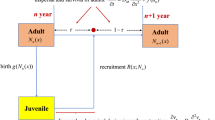Abstract
Considering the traveling wave solutions of an age-structured population model, we study the propagation patterns of a single species with respect to the diffusion rates of mature and immature population. Depending on the slope of the birth function at the positive equilibrium, the monotonic wave may change to an oscillatory wave solution, when the diffusion ratio of immature versus mature population exceeds a threshold value. This has been confirmed with numerical exploration of the traveling wave solutions.


Similar content being viewed by others
References
Al-Omari J, Gourley SA (2002) Monotone travelling fronts in an age-structured Reaction–Diffusion model of a single species. J Math Biol 45:294–312
Al-Omari JF, Gourley SA (2005) A nonlocal Reaction–Diffusion model for a single species with stage structure and distributed maturation delay. Europ J Appl Math 16(1):37–51
Allee WC (1933) Animal aggregations: a study in general sociology. Chicago University Press, Chicago
Anazawa M (2009) Bottom–up derivation of discrete-time population models with the Allee effect. Theor Popul Biol 75(1):56–67
Asmussen MA (1979) Density-dependent selection ii. The Allee effect. Am Nat 114:796–809
Aviles L (1999) Cooperation and non-linear dynamics: an ecological perspective on the evolution of sociality. Evol Ecol Res 1:459–477
Bowler DE, Benton TG (2005) Causes and consequences of animal dispersal strategies: relating individual behaviour to spatial dynamics. Biol Rev 80:205–225
Britton NF (1990) Spatial structures and periodic travelling waves in an integro-differential reaction–diffusion population model. SIAM J Appl Math 50(6):1663–1688
Gurney WSC, Blythe SP, Nisbet RM (1980) Nicholsons blowflies revisited. Nature 287:17–21
Eskola HTM, Parvinen K (2007) On the mechanistic underpinning of discrete-time population models with Allee effect. Theor Popul Biol 72:41–51
Gourley SA, Kuang Y (2003) Wavefronts and global stability in time-delayed population model with stage structure. Proc Roy Soc Lond Sect A 459:1563–1579
Gourley SA, So J, Wu J (2004) Non-locality of reaction diffusion equations induced by delay: biological modeling and nonlinear dynamics. J Math Sci 124:5119–5153
Huang J, Zou X (2006) Travelling wave solutions in delayed reaction diffusion systems with partial monotonicity. Acta Mathematicae Applicatae Sinica Engl Ser 22(2):243–256
Huang J, Zou X (2003) Existence of travelling wavefronts of delayed reaction diffusion systems without monotonicity. Dis Cont Dyn Syst (Series A) 9:925–936
Li W-T, Ruan S, Wang Z-C (2007) On the diffusive Nicholsons blowflies equation with nonlocal delay. J Nonlin Sc 17:505–525
Liang D, Wu J (2003) Travelling waves and numerical approximations in a reaction advection diffusion equation with nonlocal delayed effects. J Nonlin Sci 13:289–310
Liang D, Wu J, Zhang F (2005) Modelling population growth with delayed nonlocal reaction in two-dimensions. Math Biosci Engin 2(1):111–132
Ma S (2001) Travelling wavefronts for delayed reaction–diffusion systems via a fixed point theorem. J Diff Equ 171:294–314
Kaern M, Menzinger M (2000) Pulsating wave propagation in reactive flows: flow-distributed oscillations. Phys Rev E 61:3334–3338
Mansour MBA (2010) Traveling wave patterns in nonlinear Reaction–Diffusion equations. J Math Chem 48:558–565
Mansour MBA (2007) Accurate computation of traveling wave solutions of some nonlinear diffusion equations. Wave Motion 44:222–230
Metz JAJ, Diekmann O (1986) The dynamics of physiologically structured populations. Springer-Verlag, New York
McCarthy MA (1997) The Allee effect, finding mates and theoretical models. Ecol Model 103:99–102
Memory MC (1989) Bifurcation and asymptotic behaviour of solutions of a delay-differential equation with diffusion. SIAM J Math Anal 20:533–546
Ou C, Wu J (2007) Persistence of wavefronts in delayed nonlocal Reaction–Diffusion equations. J Differ Equ 235:219–261
Nicholson AJ (1957) The self adjustment of populations to change. Cold Spring Harb Symp Quant Biol 22:153–173
Ronce O, Clobert J, Manuel M (1998) Natal dispersal and senescence. Proc Natl Acad Sci USA 95:600–605
Ruan S (2006) Delay differential equations in single species dynamics. In: Arino O (ed) Delay differential equations and applications. Springer, New York, pp 477–517
So JW-H, Yang Y (1998) Dirichlet problem for the diffusive Nicholson’s blowflies equation. J Diff Equ 150:317–348
Smith H, Thieme H (1991) Strongly order preserving semiflows generated by functional differential equations. J Diff Equ 93:332–363
So JW-H, Zou X (2001) Travelling waves for the diffusive Nicholson’s blowflies equation. Appl Math Compt 122:385–392
Spiegel MR (1964) Theory and problems of complex variables with an introduction to conformal mapping and applications, 1st edn. McGraw-Hill Book Co, New york
So JW-H, Wu J, Zou X (2001) A reaction-diffusion model for a single species with age-structure. I Traveling wavefronts on unbounded domains. Proc Roy Soc Lond A 457:1841–1853
So JW-H, Wu J, Yang Y (2000) Numerical Hopf bifurcation analysis on the diffusive Nicholson’s blowflies equation. Appl Math Comput 111:53–69
Starr C, Evers C, Starr L (2009) Biology: today and tomorrow with physiology brooks cole, 3rd edn ISBN-10: 0495827533
Tomiyama K, Nakane M (1993) Dispersal patterns of the giant african snail, achatina fulica (férussac) (stylommatophora: achatinidae), equipped with a radio-transmitter. J Mollus Stud 59(3):315–322
Wang Z-C, Li W-T, Ruan S (2007) Existence and stability of traveling wave fronts in reaction advection diffusion equations with nonlocal delay. J Diff Equ 238:153–200
Weng P, Liang D, Wu J (2008) Asymptotic patterns of a structured population diffusing in a two-dimensional strip. Nonlin Anal 69:3931–3951
Wu J, Wei D, Mei M (2007) Analysis on the critical speed of traveling waves. Appl Math Lett 20:712–718
Wu J, Zou X (2001) Traveling wavefronts of Reaction–Diffusion systems with delay. J Dyn Diff Equ 13(3):651–687
Wu J, Zou X (2008) Erratum to traveling wave fronts of Reaction–Diffusion systems with delays. J Dyn Diff Equ 20:531–533
Yott A, Rosatte R, Schaefer JA, Hamr J, Fryxell J (2011) Movement and spread of a founding population of reintroduced Elk (Cervus elaphus) in Ontario, Canada. Restor Ecol 19:70–77
Acknowledgments
The authors would like to thank the reviewer for his valuable suggestions and his role in strengthening the results of this paper. This work was partially supported by UMKC startup fund MOCode # KCS21.
Author information
Authors and Affiliations
Corresponding author
Additional information
Communicated by André Nachbin.
Electronic supplementary material
Below is the link to the electronic supplementary material.




Appendix A: The monotone iterative method
Appendix A: The monotone iterative method
Considering the integral term in the wave Eq. (13), the functional \(H: C(\mathbb {R},\mathbb {R})\rightarrow C(\mathbb {R},\mathbb {R})\) is defined by
Then the wave Eq. (13) connecting the equilibria \(\phi _{1}\) and \(\phi _{2}\) at the two ends is represented by the Cauchy problem
As in So et al. (2001) a function \(\phi \in C(\mathbb {R},\mathbb {R})\) is called an upper (respectively, lower) solution of (39) if it is differentiable and it satisfies (39) with the sign \(\ge \) (respectively, \(\le \)). Define the wave profile of traveling wave solutions as
It can be shown So et al. (2001) that if \(b(\phi )\) is increasing in the interval \(\left[ \phi _{1},\phi _{2}\right] \), then \(H(\phi )(t)\ge 0\) for all \(t\in \mathbb {R}\), \(H(\phi )(t)\) is non-decreasing with respect to \(t\in \mathbb {R}\) and also with respect to \(\phi \in C(\mathbb {R},\mathbb {R})\). Using these properties of \(H(\phi )(t)\) and the iterative technique, the problem of constructing a traveling wavefront is reduced to the problem of finding an upper \(\overline{\phi }\) and lower \(\underline{\phi }\) solutions of (39), which satisfy the three conditions: (1) \(\overline{\phi }\in \Gamma ,\) (2) \(\phi _{1}\le \underline{\phi }(t)\le \overline{\phi }(t)\le \phi _{2}\) for all \(t\in \mathbb {R}, \) and (3) \(\underline{\phi }(t)\ne 0\). Specifically, under monotonicity condition (i.e., \(\phi _{2}<\phi _{M}\), where \(\phi _{M}\) is the local maximum of \(b(\phi )\)), the solution of (39), (40) is obtained by solving the following equation iteratively,
with boundary conditions
where \(v_{0}(t) =\overline{\phi }(t)\), \(t\in \mathbb {R}\).
In other words, \(\underline{\phi }(t)\le v_{n}(t)\le v_{n-1}(t)\le \overline{\phi }(t)\) for all \(n=1,2,\ldots \) and \(\phi (t)=\lim _{n\rightarrow \infty }v_{n}(t)\) is the solution of (39), (40). Noting that \(H(v_{n-1})(t)\) is a known function of \(t\), Eq. (42) is a non-homogeneous second-order linear differential equation with the following solution.
where \(t\in \mathbb {R}\), \(n=1,2,\ldots \) and \(\beta _{\pm }=\frac{c\pm \sqrt{c^{2}+4D_{m}d_{m}}}{2D_{m}}\). Then it can be shown [see Theorem 4.3 of So et al. (2001)] that \(v_{n}\in \Gamma \), \(\underline{\phi }(t)\le v_{n}(t)\le v_{n-1}(t)\le \overline{\phi }(t)\). For all \(n=1,2,\ldots ,\) each \(v_{n}\) is an upper solution and \(\lim _{n\rightarrow \infty }v_{n}(t) = \phi (t)\).
The work by So et al. (2001) suggests that
and
are a pair of upper and lower solutions when the birth function \(b_{1}(\phi )\) is considered and \(\frac{\epsilon p}{d_{m}}<e\), which is for the monotonicity of the wave solution. Nevertheless the upper and lower solutions should be differentiable Wu and Zou (2008). Here \(N>1\) and \(\delta >0\) are, respectively, large and small constants and \(\lambda _{1}\) is a real positive root of
which is the characteristic equation of the wave Eq. (39). The iterative method is also employed in the work by Liang and Wu (2003) where the authors have considered the same pair of upper and lower solutions when other birth functions are employed.
Rights and permissions
About this article
Cite this article
Bani-Yaghoub, M., Amundsen, D.E. Oscillatory traveling waves for a population diffusion model with two age classes and nonlocality induced by maturation delay. Comp. Appl. Math. 34, 309–324 (2015). https://doi.org/10.1007/s40314-014-0118-y
Received:
Revised:
Accepted:
Published:
Issue Date:
DOI: https://doi.org/10.1007/s40314-014-0118-y




